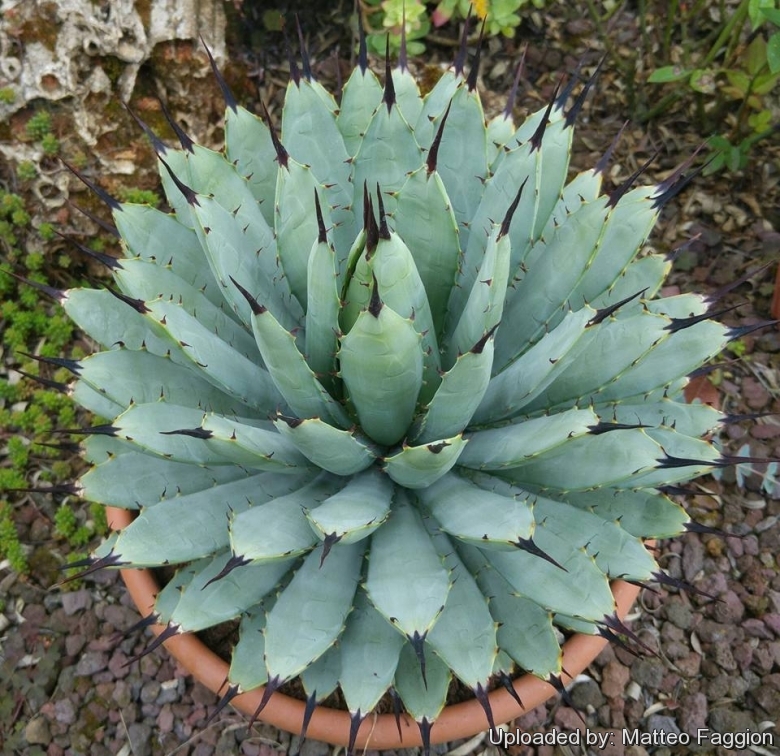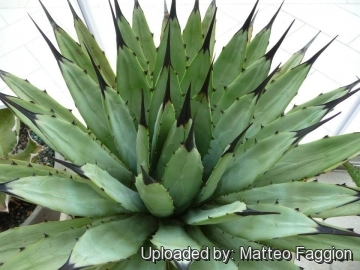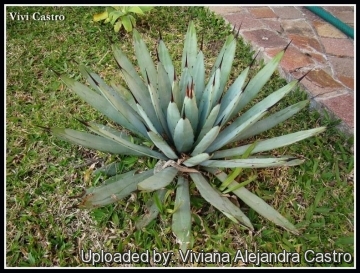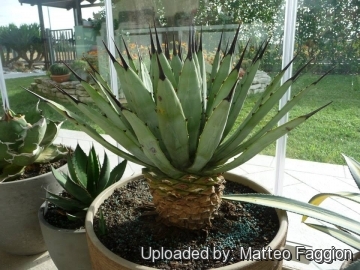
Agave macroacantha Photo by: Matteo Faggion
Origin and Habitat: Agave macroacanthaSN|516]]SN|516]] is native to northern Oaxaca and also near the town of Tehuacan in the State of Puebla, Mexico
Habitat and ecology: It grows in barren rocky, very arid terrain. It is common on the dry sedimentary slopes about Tehuacan.
Synonyms:
See all synonyms of Agave macroacantha
back
Accepted name in llifle Database:Agave macroacantha Zucc.Nova Acta Phys.-Med. Acad. Caes. Leop.-Carol. Nat. Cur. 16(2): 676. 1833Synonymy: 21
back
Common Names include:
ENGLISH: Black-spined Agave
ESTONIAN (Eesti): Suureastlaline agaav
RUSSIAN (Русский): Агава крупноколючковая, Агава широкоокаймленная
UKRAINIAN (Українська): Агава макроаканта
Description: Agave macroacantha (Black-spined Agave) is a medium sized agave that forms dense clumps to 60 cm tall by 1.5 m wide composed of very regular leaf rosettes of a bluish grey colour that can be basal or can grow on a very short stem. Leaves are succulent, narrow sword-shaped blue-grey or greyish green and up to 35 cm long at a maximum, ending in sharp, contrasting, black spines at the tips. Flowers are small, purple-tinged green with a fuzzy interior, growing in bunches on sturdy stems of up to 3 m in height,though it has been reported that the age of the plant needs to be 15 years or better to flower. In the wild it is a very variable plant, with some populations having large, jet-black terminal spines, some having red-brown spines, some with small spines, some large. Several atypical variants were also reported, some doubtless due to artificial growing in greenhouses.
Stem: Short.
Rosetes: Small, 25 - 40 cm high, usually caespitose, with numerous evenly spaced leaves spreading widely from the centre.
Leaves: Linear, rigid, radiately spreading, patulous, acuminate, 25-35 long, 2.5-3 cm, bluish-grey-glaucous, margins straight or undulate; larger marginal teeth 3-4 mm, dark brown, irregularly spaced 1-3 cm apart, with slender cusps mostly curved from small low bases. Terminal spine subulate, straight to sinuous, rounded below, flat above, 3-3.5 cm long, dark brown to grey, not decurrent.
Inflorescence: About 2 m tall, paniculate, slender, part-inflorescences shortly spreading, 10-14 in the upper 1/4 of the inflorescence. Often after the flowering there appear “ small bulbs”( already formed tiny plants) which fall to the ground, giving life to a new colony of Agaves. When this plant begins to flower the center leaves take on an attractive reddish hue from where the dark red inflorescence begins to emerge
Flowers: 50-56 mm; Ovary angular-fusiform, 25-30 mm, neck constricted, deeply grooved; Tepals pruinose green with purple tinge, tube 14 mm, lobes more or less equal, 13-16 mm, quickly wilting at anthesis. Filaments 35-40 mm long, sharply bent from regular insertion 7-8 mm above base of tube, spotted; anthers spotted, 20-21 mm long, slightly excentric.
Blooming season: Spring to summer.
Fruits (capsules): Oblong 4.5 long, 2 cm in diameter, dark brown, stipitate, with constricted prominent beak.
Seeds: 6-7,mm long, 4-5 mm, triangular, dull black.
Subspecies, varieties, forms and cultivars of plants belonging to the Agave macroacantha group
 Agave macroacantha Zucc.: forms clumps to 60 cm by 1.5 m composed of bluish grey rosettes. Leaves sword-shaped to 35 cm long with black spines at the tips. Distribution: Oaxaca and Tehuacan in the State of Puebla.
Agave macroacantha Zucc.: forms clumps to 60 cm by 1.5 m composed of bluish grey rosettes. Leaves sword-shaped to 35 cm long with black spines at the tips. Distribution: Oaxaca and Tehuacan in the State of Puebla. Agave macroacantha viridis hort.: has a bluish-green leaves, but it is hard to tell apart it from the stand species, if not for the foliage colouration.
Agave macroacantha viridis hort.: has a bluish-green leaves, but it is hard to tell apart it from the stand species, if not for the foliage colouration.
Bibliography: Major references and further lectures:
1) J. Thiede: “Agave macroacantha.” In: Urs Eggli “Illustrated Handbook of Succulent Plants: Monocotyledons: Monocotyledons” Springer Science & Business Media, 17/Jul/2001
2) Park S. Nobel “Environmental Biology of Agaves and Cacti” Cambridge University Press, 16/Oct/2003
3) Wikipedia contributors. "Agave macroacantha." Wikipedia, The Free Encyclopedia. Wikipedia, The Free Encyclopedia, 30 Jan. 2014. Web. 4 Nov. 2014.
4) Gentry, Howard Scott. "Agaves of Continental North America." University of Arizona Press, Tucson, 1992.
5) San Marcos Growers contributors “Agave macroacantha - Black-spined Agave ” San Marcos Growers <http://www.smgrowers.com>. Web. 27 Sep. 2014.
6) Mary and Gary Irish “Agaves, Yuccas, and Related Plants: A Gardener's Guide” Timber Press, 2000
7) August J. Breitung “Agave macroacantha”. In: “The Agaves.” The Cactus & Succulent Journal Yearbook, 1968
8) T. Heller “Agaven.” Münster 2006 .
9) W. Trelease “Agave macroacantha and allied Euagaves.” In: Annual Rep. Missouri Bot. Gard. 18: 231–256 1907
 Agave macroacantha Photo by: Matteo Faggion
Agave macroacantha Photo by: Matteo Faggion Agave macroacantha Photo by: Viviana Alejandra Castro
Agave macroacantha Photo by: Viviana Alejandra Castro Agave macroacantha Photo by: Matteo Faggion
Agave macroacantha Photo by: Matteo FaggionSend a photo of this plant.The gallery now contains thousands of pictures, however it is possible to do even more. We are, of course, seeking photos of species not yet shown in the gallery but not only that, we are also looking for better pictures than those already present.
Read More... Cultivation and Propagation: Agave macroacanthaSN|516]]SN|516]] (Black-spined Agave) is a stunning specimen plant for containers. In milder climates this plant grows well outdoor in full sun (Light shade or eastern exposure in hot areas), plant in deep well drained soil where the climate is suitable ( coastal zones and islands). The plants in pot tend to be slow grower, but worth the effort.
Growth rate: Agave macroacanthaSN|516]]SN|516]] is relatively slow growing, taking several years to reach flowering size.
Soil: Plant in well-drained soil. It is better to use wide pots which allow space for the roots of the Agave macroacanthaSN|516]]SN|516]] to grow.
Repotting: Every two years the pots should be changed, shortening the roots and eliminating the buds which suck the goodness from the plant, limiting its growth.
Exposure: Full sun or light shade or eastern exposure in hot low desert areas.
Waterings: Water thoroughly when soil is dry to the touch. In winter watering this plant can be done once every 1-2 months, there is no need to mist the leaves. The blue-and blue-gray-leaved forms are from very arid areas, and once established in ground the plants should be kept dry to prevent any potential rot. The blue-green-leaved form is from slightly more moist areas, and will tolerate extra water.
Hardiness: Agave macroacanthaSN|516]]SN|516]] can tolerate nighttime air temperatures of -6°C when droughted but not if watered and it is best to avoid severe freezing temperatures.
Heat Tolerance: Excellent.
Propagation: Agave macroacanthaSN|516]]SN|516]] can sexually reproduce by seeds and propagate vegetatively by aerial bulbils and ground-level basal shoots and rhizomes. It suckers, but not an aggressive spreader in the garden. Remove the basal suckers in spring or summer and let the cuttings dry for a few days before inserting in compost. The only problem is the logistics of getting to the suckers - very sharp spines and suckers usually right up against, or underneath the mother plant.
Uses: These striking plants are wonderful when used for accent or simply to provide some all year round foliage colour and often used in a pot as a patio plant, they make an eye-catching statement and along with other evergreen plants in pots, can be moved around to change the scenery or position to give more shelter.













